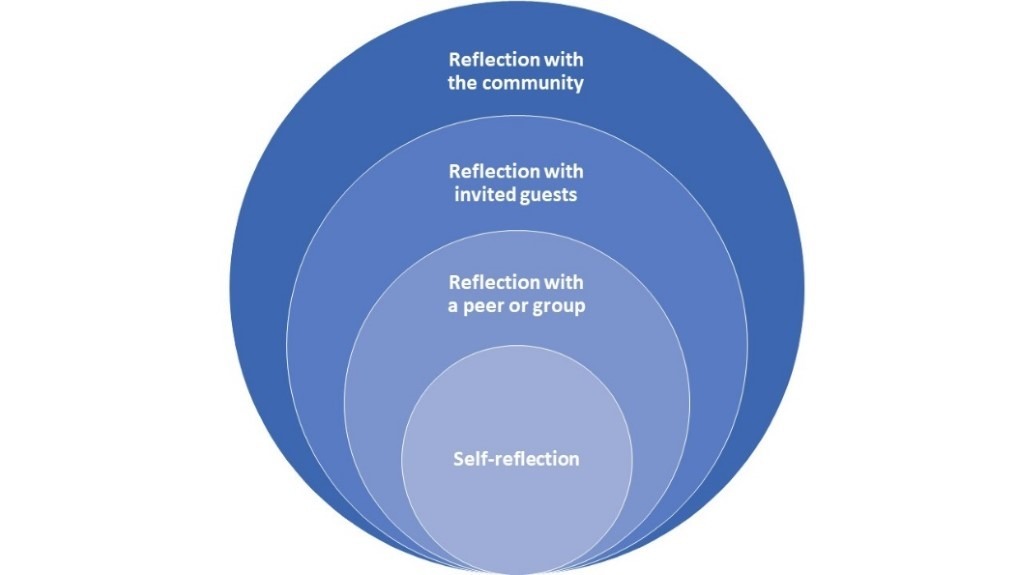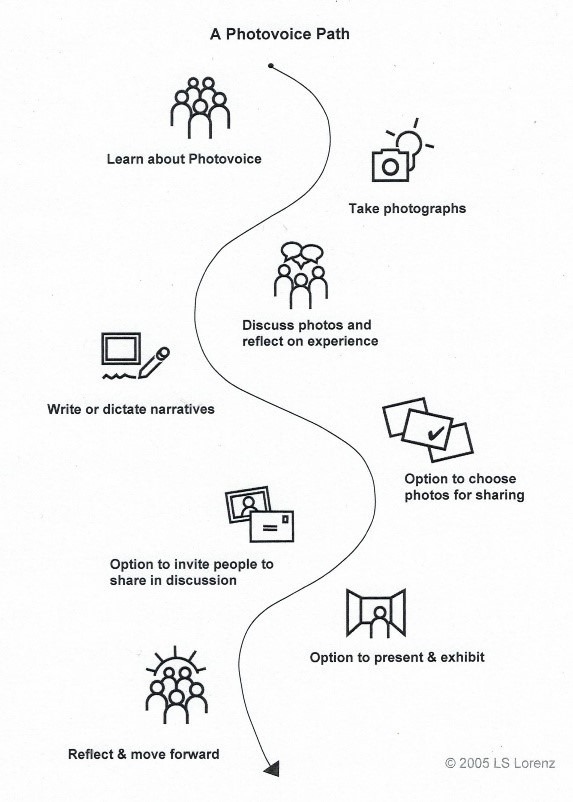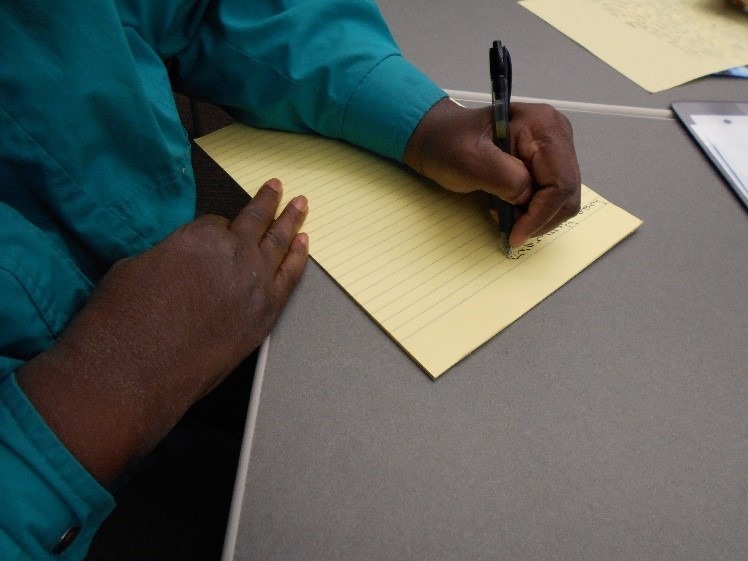by Laura Lorenz and Erin Bush
A colleague recently asked us about critical thinking and photovoice, and her interest prompted us to reflect on this topic and share our thoughts. In part 1 – this post – we identify photovoice tasks that use critical thinking. In Part 2 we will share strategies to strengthen critical thinking with photovoice.
Overview
Critical thinking is a cognitive process that influences our thinking, attitudes, and actions. A critical thinking process involves reflecting, observing, experiencing, and communicatingi. Usually we are unaware of this process – it takes place whether we pay attention to it or not! With photovoice we get the chance to intentionally look at our lives and circumstances through the lens of a camera. Critical thinking can open our eyes to aspects of our lives and circumstances that might be helping us or causing us harm. In our daily lives it is difficult to notice what is right in front of us. Because we see that help or harm every day, it no longer attracts our notice or attention. With photovoice, we practice critical thinking when we reflect on our circumstances with new eyes, capture photos of what matters to us, share them with others, and communicate the thoughts and feelings that the photos represent.
Paolo Freire (1974) encouraged the practice of critical thinking not to deny a fact, but to “see it differently.”ii With a camera in hand, photovoice participants can observe their lives differently through a camera lens. Paolo Freire also encouraged us to “care about the dignity and worth of every person” through critical thinking.iii Without an overarching sense of caring, critical thinking risks causing harm to people. Seeing personal circumstances with new eyes can mean understanding the structural and systemic inequalities – such as poorly resourced healthcare systems or schools – affecting us, and the role these inequalities play in our lives and circumstances.
Since the mid-1900s, creative thinking has emerged as a complement to critical thinking.iv,v Creative thinking involves developing new ideas to address the problems or support the strengths identified with photovoice. Critical and creative thinking interact to create understanding and inform action.
Now let’s consider the photovoice steps and tasks that build participants’ critical and creative thinking skills.
Critical and Creative Thinking and Photovoice
Step 1: Answering questions with a camera means reflecting and observing. Critical thinking begins right away with photovoice, as participants observe their surroundings and use their cameras to take pictures that answer questions, such as: what do I think is a strength or a challenge in my life or community? The questions prompt reflection.
- What do I care about?
- What do I think or feel?
- How can I show this in a photo?
Step 2: Communicating is basic to photovoice. With photovoice, communication involves not only taking and sharing the pictures, but speaking, listening, and writing about them too. Critical thinking occurs as photovoice group members bring their photos to the group and explain with they mean by communicating what they see in the photo and, comparing and contrasting their own perspective with another’s. The photo generates dialogue as people talk about their lives, thoughts, and feelings. Group members may experience new empathy for each other and a sense of altruism or caring. Critical thinking occurs again when participants write photo captions, to communicate with people outside the photovoice group.
Step 3: Observing commonalities by identifying themes. Photovoice can result in a large group of photos to share with others. One recommended photovoice task is to involve participants in grouping project photos into themes. When discussing photos and experiences during project sessions, common experiences and recurring themes likely arise. Identifying themes and using them to group project photos and captions engages our critical thinking skills.
- What do these photos have in common?
- What name helps to show their commonality?
Asking these questions can help us identify and name themes. This important cognitive work helps us to observe our common experiences and feel a greater connection with the project and the group. An exhibit represents a collective experience that can help us to think creatively and open our minds to possibilities we had not thought of before.
Step 4: Communicating to power: Advocacy and outreach. Understanding about advocacy and outreach can evolve during a photovoice project. As the deep connections formed through shared thoughts and feelings emerge, photovoice participants often experience a sense of ownership in the data, and care and concern for what will become of the photos and captions.
- Who will see the exhibit?
- Where will it be displayed?
- Will the “right” people – who can affect change – get to see it?
We want our work to be viewed by people who will want to see it, are willing to learn something new, and/or have the ability to create change. As we consider the “right” audiences for our photovoice work we engage in critical thinking to determine logically where the display will be most accessible and effective, and the best way to get people to see it. We put ourselves in policymakers’ shoes – what information will motivate them to create change? Creative thinking plays a role as well, allowing us to go beyond the expected outreach efforts and think of new ones. Photovoice participants further promote their work by thinking creatively about ways to increase its visibility.
Ever-widening Circles. Another way to think about critical and creative thinking and photovoice is through ever-widening circles, from self-reflection or communication with oneself, to reflection and communication with a peer, in a group, and, finally with the community.
A step-wise process of self-reflection in ever-widening circles can provide a safe, respectful way for people to dig deeper into themselves and their understanding of their lives and circumstances. The process is bi-directional as we can move thru the circles outward and then reflect again on ways that the circles impact us, in turn. An important role for photovoice facilitators is to support critical and creative thinking processes and the learning they can engender – for individuals, groups, clinicians, and communities.
Conclusion
Critical and creative thinking are skills that can be developed by people of any age, any level of education, and any level of cognitive ability. Building these skills is a lifelong endeavor. We travel with our photovoice participants for a short time in their lifelong journeys. Practice with critical and creative thinking during a photovoice project can plant seeds for lifelong learning and growth. With photovoice, critical and creative thinking means helping participants to build the knowledge, awareness, and skills needed to reach their goals and dreams – for themselves, their peers, and their communities.
Next time we will discuss strategies to encourage practice with critical and creating thinking during photovoice.
Ever-widening Circles

Photovoice encourages a step-wise process of self-reflection in ever-widening circles.
A Photovoice Path

Practice and learning with critical and creative thinking occur at many different points in the photovoice process, from reflecting on about the project topic, to taking a photo, writing a caption, and identifying audiences for your exhibit.
Writing is a Critical Part of Photovoice

Writing photo captions encourages critical thinking. Why is this photo meaningful to me? What do I want to tell others?
Erin Bush is an assistant professor in the Communication Disorders division at the University of Wyoming. Before attending the University of Nebraska Lincoln for her doctorate, Erin worked in medical and rehabilitation facilities as a speech-language pathologist. She teaches and conducts research regarding acquired neurogenic communication disorders, and her work has mostly been with people who have had a TBI, stroke, or other neurological condition such as Parkinson’s disease. She also has a specific interest in qualitative research methodologies. Erin attended the Photovoice Worldwide training in March and has been working with Laura since that time on blogs as well as an upcoming webinar about critical and creative thinking with photovoice!
Laura Lorenz is co-founder and educator at PhotovoiceWorldwide LLC. She has a PhD in health policy and health services research from Brandeis University and a Master of Education (Instructional Design/Adult Education) from the University of Massachusetts at Boston. Laura has been using photovoice since 2001 with girls, youth, people living with brain injury, older adults, and people living with mental illness. She has published in peer-review journals and books on disability, brain injury, health, healthcare, cost-effectiveness, managed care, rehabilitation, research involvement, sociology, visual education, and visual methods. She facilitates the professional development course ‘Talking with Pictures’: Photovoice.
